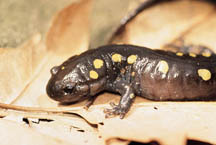There have been plenty of studies on the effects of road salt on wetlands, and particularly on the amphibians that live in those wetlands. (Here’s a bibliography with seven pages of peer-reviewed papers on the subject, plus over a page of other information sources.)
But because so much of that work was done by Nancy Karraker when she was at State University of New York College of Environmental Science and Forestry, James Petranka of the University of North Carolina – Asheville wanted to know how road salt effected amphibians in the southeastern United States — the site of enormous salamander diversity, says an article in the Charlotte Observer.
What he found was that road salt’s impact on the invertibrates in a vernal pool is crucial to the development of the amphibians there, and possibly, to public health. That’s because the salamander larvae eat water fleas, copepods and other invertebrates that don’t fare well in salty water. What’s more, mosquitoes didn’t seem to have any problem with the salty water, and one of the mosquito species that volunteered in the salty test pools carries West Nile Virus.
Read the excellent article in the Charlotte Observer.
A paper on Petranka’s research was published in the journal Aquatic Ecology in 2010. Read the abstract here. (Fee or subscription required for the full article.)
The Adirondack road salt journal article that the newspaper article refers to is most likely this comprehensive 2008 paper on the impact of road salt on wood frogs and spotted salamanders in New York. (Because this article is cited in Petranka’s 2010 paper.)
But Karraker also published a compelling 2011 paper showing how road salt shrivels the egg masses of spotted salamanders that does not appear in her 2007 bibliography.
Photo: Spotted salamander by Tom Tyning, courtesy of the US Department of Transportation

